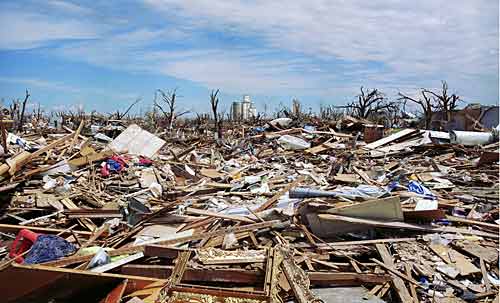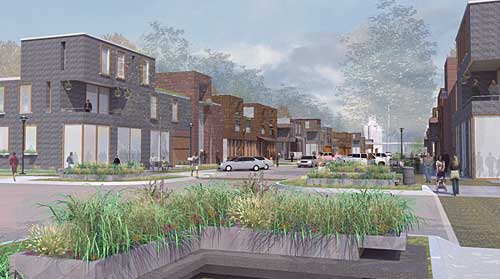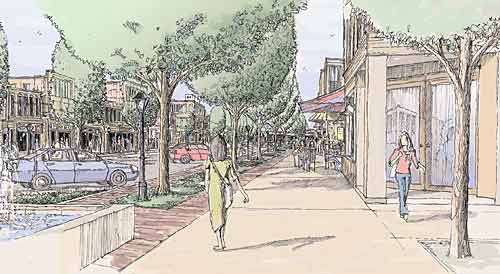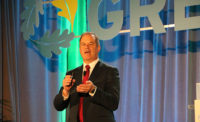On May 4, 2007, a tornado tore through Greensburg, Kansas, wreaking almost complete destruction of this 1,574-person town located two hours west of Wichita. Measuring EF-5 in intensity, indicating wind speeds of more than 200 miles per hour, the twister swept up Greensburg’s main commercial street, leaving nothing standing in its wake but for one corner bank. Reports tallied nine deaths from the storm, as well as property damage in excess of $150 million.
 The site of Greensburg’s former hospital, photographed by Greensburg native Larry Schwarm the day after the tornado hit. Photo © Larry Schwarm |
As early as the summer of 2007 municipal authorities determined to reconstruct Greensburg using sustainable design principles and techniques. The latest milestones in this effort came in December, when the city passed a first-ever resolution to certify all public buildings larger than 4,000 square feet as LEED Platinum. Just days later the city council adopted the first phase of a sustainable comprehensive master plan conceived by Kansas City, Missouri–based Berkebile Nelson Immenschuh McDowell Architects; Greensburg had retained BNIM and environmental consultant John Picard in October 2007 to guide the rebuilding process.
 Schwarm also assembled this panorama of Greensburg’s downtown. Larry Schwarm: Greensburg After the Storm, an exhibit of his photographs, opens April 26 at the Ulrich Museum of Art, at Wichita State University. It runs through August 10. Photo © Larry Schwarm |
BNIM associate Stephen Hardy, who, with colleague Rachel Weden, was largely responsible for the sustainable master plan, says of the LEED Platinum announcement, “While you wouldn’t pick western Kansas as a hotbed for sustainability, we’ve found that [Greensburg officials and residents] understand natural systems and have absorbed progressive green thinking much more deeply than their urban counterparts.” The master plan, which stresses walkability, water conservation and stormwater management, and citywide-wind power, also may contribute to the goal. Hardy imagines building owners opting into municipal wind power instead of producing their own renewable energy on site.
 The future of Greensburg as it might appear. The town council has mandated that all public buildings achieve LEED Platinum. Image courtesy Berkebile Nelson Immenschuh McDowell Architects |
Picard, who will be a recurring character in this summer’s 13-part Discovery Channel series about the environmentally friendly rebuilding of Greensburg, cautions that despite the city’s green ordinance not all that’s getting built is sustainable. “In terms of homes, did some people build back green? Somewhat. But we didn’t get the chance to effect really significant, across-the-board change in the residential work.” With assistance from the U.S. Department of Agriculture, as well as from nonprofits and philanthropists, more than 100 residences are already under construction and one retail building is already completed. Picard says that 10 commercial and public buildings had already committed to obtaining LEED certification as per Greensburg’s earlier Green Initiative. Other projects that should earn Platinum include local John Deere and GM dealerships.
 Already, 10 commercial and public buildings had already committed to obtaining LEED certification. Image courtesy Berkebile Nelson Immenschuh McDowell Architects |
Residents and city officials hope that public as well as private green initiatives could ensure the economic viability of Greensburg, where population has been consistently decreasing as younger residents seek jobs and excitement in larger urban areas. They envision sustainability as a business engine, fueling tourism and a new generation of manufacturing jobs. Economic development is just one component of BNIM’s phase-two sustainable comprehensive master plan, which the city council is expected to adopt this month.



Post a comment to this article
Report Abusive Comment